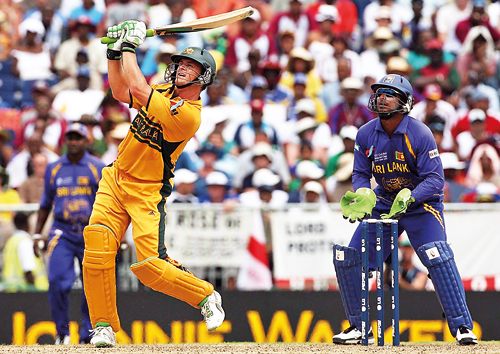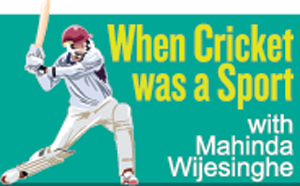A bad cricket memory recounted yet again
View(s):
When Adam Gilchrist single-handedly guided the Aussies to a potential world cup title, with a squash ball in his gloves
In 1996, Sri Lanka humbled Australia in the Cricket World Cup finals by 7 wickets and annexed the plum. Lanka was now recognised as a proud cricketing nation on her own right. Eleven years later, the two teams met again in the finals. Will Sri Lanka repeat their feat? After all, Sri Lanka had batsmen of the caliber of Jayasuriya, Sangakkara, skipper Jayawardene and Dilshan and bowlers, Vaas, Murali and Malinga. It probably may have repeated their earlier feat but for a “freak” innings from Adam Gilchrist. Recounting the memory is not easy but painful memories still linger. Firstly, let’s have a look at the Laws of Cricket has to say on this issue.
The Laws of Cricket – Code 2000 sub-section 6 refers to: “conduct of the game, implements and equipment:
Before the toss and during the match, the umpires shall satisfy themselves that
(a) The conduct of the game is strictly in accordance with the laws.
(b) The implements of the game conform to the requirements of Law 5 (The ball) and 6 (The bat) together with either laws 8.2 (Size of stumps) and 8.3 (The bails) or, if appropriate, law 8.4 (junior cricket)
(c) (1) no player uses equipment other than that permitted……..(emphasis mine. MW)
(11) the wicketkeeper’s gloves comply with the requirement of law 40.2 (Gloves)”
Interestingly, Law 6 (c) (1) came into focus when Australia beat Sri Lanka in the final of the 2007 World Cup by 53 runs on the D/L method and Adam Gilchrist, having scored 149 runs was adjudged Man of the Match – rightfully on the statistics.
But did Gilchrist conform rightfully as per Law 6 (c) (1)? The answer is “questionable” in the extreme.
In the sport, according to Marquess of Queensbury Rules (Boxing), the Referee could if he wants, check the gloves of the boxers if they are having anything hidden (inside their gloves) to enable them get an unfair advantage.
Similarly, if the umpires officiating in the final of the 2007 Cricket World Cup at the Kensington Oval, Barbados, Aleem Dar and Steve Bucknor, bothered to check what was inside Gilchrist’s left glove, there would have been some surprises. Because lodged inside his glove was part of a squash ball – innocently or otherwise.
Now this contravenes Law 6 (c) (1) as above.
Let us now look at how Gilchrist fared in the run-up until the final. Except for a couple of half-centuries against the lowly (at that time) Bangladesh, and Netherlands, Gilchrist had nothing much to write home about. Then how did he suddenly thump 100 runs in boundaries against Sri Lanka in the finals and take Australia to a score of 281/4 in a mere 38 overs while outstanding stroke makers such as Hayden, Ponting, Symonds, Watson and Clarke contributed a mere 127 runs sans a single half-century? To add further, this quintet of batsmen registered only 7 fours and 2 sixes while Gilchrist tonked 13 fours and 8 sixes!
Let his mentor, former squash and Sheffield Shield player in the 1960’s, Bob Meuleman, explain the sensational innings:
“He (Gilchrist) had a few hits before he went off to the World Cup; he didn’t have the squash ball in and he hit them like he couldn’t even play fourth grade. He put it (half squash ball) in and he then hit the ball so good…….I’ve worked with him for 10 years and he an unusual grip in which his hand goes too far around the back of the bat. It [the squash ball] is a great big lump in your glove but it means that you can only use your bottom hand in a V.”
Indeed, a staggering 65 runs, or 44% of his runs, were rifled from strokes in the V, including six fours and five sixes! Need one say more about the usefulness of the squash ball?
It appears this ploy was used not realizing the fact it contravenes the Laws of Cricket. But why this was not subsequently used raises many a question.
A player may use external aids ( this is only to prevent injury) such as a helmet, pads, chest guards, gloves and so on, and sometimes it has been alleged a wicket-keeper may even use a piece of meat inside his gloves for the same reason! Here is the scientific explanation for this phenomenon of how Gilchrist had this advantage:
 “A squash ball is a rubber ball. Unlike a cricket (leather) ball, it compresses when pressure is applied on it. When the pressure is released it takes it original shape. In short, it acts like a spring (e.g. A motor cycle shock absorber). So what happens when a batsman has a squash ball in the palm of his bottom hand? When a batsman swings the bat until it hits the ball, there is pressure on his bottom hand. This pressure compresses the squash ball similar to spring. Just after the ball hits the bat (ball still touching the bat) this pressure starts to relax while the bat is moving forward. At the same time the energy stored in the squash ball releases its energy in the form of kinetic energy. The result is that the bat moves faster than normal (without a ball in the glove). As a result, the release speed of the cricket ball becomes faster resulting in the ball traveling further before hitting the ground…………the downside is because the bat travels faster than normal the batsman might lose control of the bat. This happened once in the Adam Gilchrist innings when the bat slipped out of his hands and fell behind the wickets………in brief Gilchrist’s use of the squash ball allowed him to hit the ball further in the field.”
“A squash ball is a rubber ball. Unlike a cricket (leather) ball, it compresses when pressure is applied on it. When the pressure is released it takes it original shape. In short, it acts like a spring (e.g. A motor cycle shock absorber). So what happens when a batsman has a squash ball in the palm of his bottom hand? When a batsman swings the bat until it hits the ball, there is pressure on his bottom hand. This pressure compresses the squash ball similar to spring. Just after the ball hits the bat (ball still touching the bat) this pressure starts to relax while the bat is moving forward. At the same time the energy stored in the squash ball releases its energy in the form of kinetic energy. The result is that the bat moves faster than normal (without a ball in the glove). As a result, the release speed of the cricket ball becomes faster resulting in the ball traveling further before hitting the ground…………the downside is because the bat travels faster than normal the batsman might lose control of the bat. This happened once in the Adam Gilchrist innings when the bat slipped out of his hands and fell behind the wickets………in brief Gilchrist’s use of the squash ball allowed him to hit the ball further in the field.”
Some or most of Gilchrist’s sixes simply soared out of the playing area and well into the stands.
Finally, if this ploy of using a part of a squash ball was so useful why wasn’t it used again? Or put another way, if a Jayasuriya, Dilshan or a Sangakkara used this ploy what would have been the repercussions?


